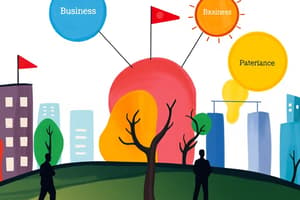Podcast
Questions and Answers
Match the following components of the general environment with their descriptions:
Match the following components of the general environment with their descriptions:
Economic = Interest rates, inflation, and unemployment Technological = Advancements in production and distribution technology Political and legal = Government regulation and political stability Socio-cultural = Customs, values, and lifestyles of a population
Match the following types of environmental uncertainty with their characteristics:
Match the following types of environmental uncertainty with their characteristics:
Degree of change = Frequency of components changing Complexity = Number of components and knowledge about them General environment = Broad factors impacting all organizations Competitive environment = Specific industry-related factors
Match the following major forces in the general environment with their areas of concern:
Match the following major forces in the general environment with their areas of concern:
Demographic = Population characteristics like age and gender Environmental = Sustainable production methods and pollution International = Engagement with foreign business activities Legal = Company taxation and trade agreements
Match the following factors with their respective international PESTEL categories:
Match the following factors with their respective international PESTEL categories:
Match the following components of the competitive environment with their definitions:
Match the following components of the competitive environment with their definitions:
Match the following socio-cultural factors with their examples:
Match the following socio-cultural factors with their examples:
Match the following forms of environmental change with their implications:
Match the following forms of environmental change with their implications:
Match the following legal factors with their implications for businesses:
Match the following legal factors with their implications for businesses:
Match the competitive forces with their definitions:
Match the competitive forces with their definitions:
Match the organizational culture characteristics with their descriptions:
Match the organizational culture characteristics with their descriptions:
Match the types of stakeholders with their roles:
Match the types of stakeholders with their roles:
Match the elements influencing organizational culture with their explanations:
Match the elements influencing organizational culture with their explanations:
Match the levels of organizational culture with their examples:
Match the levels of organizational culture with their examples:
Match the dimensions of organizational culture with their focuses:
Match the dimensions of organizational culture with their focuses:
Match the types of external stakeholders with their interests:
Match the types of external stakeholders with their interests:
Match each stakeholder type to their expectations:
Match each stakeholder type to their expectations:
Match the definitions of barriers to entry with their examples:
Match the definitions of barriers to entry with their examples:
Match the aspects of rivalry with their influences:
Match the aspects of rivalry with their influences:
Match each organizational culture level with its significance:
Match each organizational culture level with its significance:
Match the types of power in bargaining with their descriptions:
Match the types of power in bargaining with their descriptions:
Match the components of culture establishment with their effects:
Match the components of culture establishment with their effects:
Flashcards
Business Environment
Business Environment
Factors outside an organization that affect its performance. Think of it as the big picture influencing the company.
Environmental Uncertainty
Environmental Uncertainty
The degree of change and complexity in an organization's surrounding environment. It has two aspects: how much things change and how many different factors exist.
General Environment
General Environment
The broader set of factors that impact all businesses in a region or globally. Think of it as the overall landscape that influences everyone.
Competitive Environment
Competitive Environment
Signup and view all the flashcards
Economic Factors
Economic Factors
Signup and view all the flashcards
Technological Factors
Technological Factors
Signup and view all the flashcards
Political and Legal Factors
Political and Legal Factors
Signup and view all the flashcards
Socio-cultural Factors
Socio-cultural Factors
Signup and view all the flashcards
Porter's Five Forces
Porter's Five Forces
Signup and view all the flashcards
Rivalry Among Competitors
Rivalry Among Competitors
Signup and view all the flashcards
Barriers to Entry
Barriers to Entry
Signup and view all the flashcards
Bargaining Power of Suppliers
Bargaining Power of Suppliers
Signup and view all the flashcards
Bargaining Power of Buyers
Bargaining Power of Buyers
Signup and view all the flashcards
Threat of Substitutes
Threat of Substitutes
Signup and view all the flashcards
Organizational Culture
Organizational Culture
Signup and view all the flashcards
Strong Culture
Strong Culture
Signup and view all the flashcards
Weak Culture
Weak Culture
Signup and view all the flashcards
Visible Artefacts
Visible Artefacts
Signup and view all the flashcards
Invisible Culture
Invisible Culture
Signup and view all the flashcards
Adaptability
Adaptability
Signup and view all the flashcards
Stakeholders
Stakeholders
Signup and view all the flashcards
Internal Stakeholders
Internal Stakeholders
Signup and view all the flashcards
Study Notes
Business Environment
- Environment encompasses external institutions influencing organizational performance.
- Environmental uncertainty: the degree of change and complexity in the environment, affecting organizational performance.
- Degree of change: frequency of component changes within the environment.
- Complexity: the number of environment components and organizational knowledge about them.
General Environment
- Two levels of organizational external environments: general and competitive.
- General environment: factors affecting all organizations, including:
- Political, economic, socio-cultural, technological, environmental, and legal factors.
- Major forces in the general environment:
- Economic: Interest rates, inflation, unemployment, economic growth.
- Technological: Infrastructure, advancements, industrial innovations, changes in tech for producing & distributing goods/services.
- Political and legal: Political stability, government regulation, changes in laws/regulations.
- Socio-cultural: Customs, values, traditions, lifestyles, beliefs and patterns of behavior.
- Demographic: Population characteristics (age, gender, ethnicity, sexual orientation, social class).
- Environmental: Production methods, sustainable energy, climate change.
- International: Involvement and impact of international business.
- International PESTEL Analysis:
- Political: Government attitudes, stability, patent/intellectual property policy.
- Economic: Growth, wealth distribution, currency, exchange rates.
- Socio-cultural: National cultures, attitudes to foreign companies.
- Technological: Telecommunications, power supply, import/export infrastructure.
- Environmental: Natural resources, environmental quality, climate change.
- Legal: Tariffs, trade agreements, employment, taxation.
Competitive Environment
- Competitive environment: forces affecting input/output; suppliers, distributors, customers, competitors.
- Suppliers: Provide input resources (receive payment).
- Distributors: Help sell goods/services.
- Customers: Purchase goods/services.
- Competitors: Offer similar goods/services.
Porter's Five Forces Model
- Analyzes industry attractiveness.
- Rivalry among competitors: High rivalry = low attractiveness and profits.
- Factors: Number of competitors, demand growth, product differentiation, barriers to exit.
- Threat of new entrants: Low barriers = low industry profits.
- Factors: Barriers to entry (capital investment, economies of scale, licenses, customer loyalty).
- Bargaining power of suppliers: High supplier power = low industry profits.
- Factors: Number of suppliers, customer purchasing patterns, supplier expansion, cost of switching suppliers.
- Bargaining power of buyers: High buyer power = low industry profits.
- Threat of substitutes: Products in other industries fulfilling similar needs.
- Rivalry among competitors: High rivalry = low attractiveness and profits.
Organizational Culture
- Internal environment includes organizational people, culture, structure, technology.
- Organizational culture: Shared values, principles, traditions influencing member behavior.
- Strong culture: Values widely shared, behaviors clearly connected, employee identification.
- Weak culture: Values limited to top management, employees don't identify.
- Levels of culture:
- Visible artefacts: Dress, behaviours, symbols, ceremonies, office layout.
- Invisible:
- Values, beliefs (interpretations of stories, language).
- Underlying assumptions (role modeling, legends, coded language).
- Dimensions of organizational culture:
- Adaptability, attention to detail, outcome orientation, people orientation, team orientation, integrity.
- Organizational culture: Shared values, principles, traditions influencing member behavior.
Stakeholders
- Stakeholders: Individuals/groups with interest in the company's activities & performance.
- External stakeholders: Customers, suppliers, creditors, governments, unions, local communities, general public.
- Internal stakeholders: Stockholders, employees, managers, executives, board members.
- Different stakeholder claims; stockholders maximize returns, managers balance stakeholder interests efficiently, employees seek rewards, suppliers/distributors seek fair compensation, customers demand products to stay in business, community supports infrastructure.
Studying That Suits You
Use AI to generate personalized quizzes and flashcards to suit your learning preferences.




